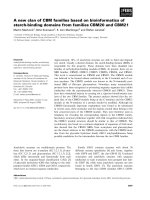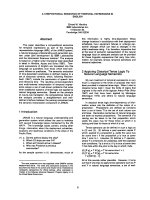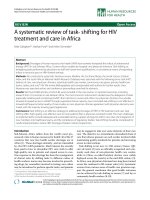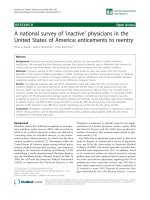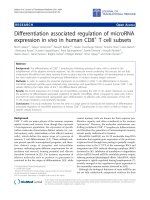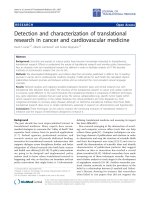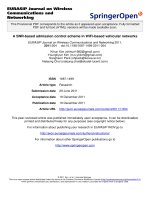Báo cáo sinh học: " A new example of viral intein in Mimivirus" ppt
Bạn đang xem bản rút gọn của tài liệu. Xem và tải ngay bản đầy đủ của tài liệu tại đây (299.6 KB, 7 trang )
BioMed Central
Page 1 of 7
(page number not for citation purposes)
Virology Journal
Open Access
Research
A new example of viral intein in Mimivirus
Hiroyuki Ogata*
1
, Didier Raoult
2
and Jean-Michel Claverie
1
Address:
1
Information Génomique et Structurale, UPR2589 CNRS, IBSM, IFR88, 31 chemin Joseph Aiguier, 13402 Marseille Cedex 20, France and
2
Unité des Rickettsies, CNRS UPRESA 6020, Faculté de Médecine, 27 Boulevard Jean Moulin, 13385 Marseille Cedex 05, France
Email: Hiroyuki Ogata* - ; Didier Raoult - ; Jean-Michel Claverie - Jean-
* Corresponding author
Abstract
Background: Inteins are "protein introns" that remove themselves from their host proteins
through an autocatalytic protein-splicing. After their discovery, inteins have been quickly identified
in all domains of life, but only once to date in the genome of a eukaryote-infecting virus.
Results: Here we report the identification and bioinformatics characterization of an intein in the
DNA polymerase PolB gene of amoeba infecting Mimivirus, the largest known double-stranded
DNA virus, the origin of which has been proposed to predate the emergence of eukaryotes.
Mimivirus intein exhibits canonical sequence motifs and clearly belongs to a subclass of archaeal
inteins always found in the same location of PolB genes. On the other hand, the Mimivirus PolB is
most similar to eukaryotic Polδ sequences.
Conclusions: The intriguing association of an extremophilic archaeal-type intein with a mesophilic
eukaryotic-like PolB in Mimivirus is consistent with the hypothesis that DNA viruses might have
been the central reservoir of inteins throughout the course of evolution.
Background
Mimivirus is the largest known virus, both in particle size
(>0.4 µm in diameter) and genome length, recently dis-
covered in amoeba, following the inspection of a hospital
cooling tower prompted by a pneumonia outbreak [1].
Recently, its entire 1.2-Mbp genome sequence was deter-
mined [2]. Extensive phylogenetic studies and gene con-
tent analyses defined Mimivirus as a new family of
nucleocytoplasmic large DNA viruses (NCLDV) besides
Poxviridae, Iridoviridae, Phycodnaviridae and Asfarviridae,
and suggested its early origin, probably before the individ-
ualization of the three domains of life [2].
While analyzing Mimivirus genome sequence, we noticed
the unusual length of its putative DNA polymerase. A
detailed analysis identified an intein in this gene. After the
recent discovery of an intein in Chilo iridescent virus [3],
an insect-infecting NCLDV of Iridoviridae, this is the sec-
ond report of an intein sequence in a eukaryote-infecting
virus.
Inteins are "protein introns" that catalyze self-splicing at
the protein level. The splicing is defined by the self-cata-
lytic excision of an intervening sequence ("intein") from a
precursor host protein where it is located, and the con-
comitant ligation of the flanking amino- and carboxy-ter-
minal fragments ("exteins") of the precursor. Inteins often
possess a homing endonuclease domain, and are consid-
ered as mobile elements. Since their first discovery in
1990 [4,5], inteins have been identified in a wide variety
Published: 11 February 2005
Virology Journal 2005, 2:8 doi:10.1186/1743-422X-2-8
Received: 10 January 2005
Accepted: 11 February 2005
This article is available from: />© 2005 Ogata et al; licensee BioMed Central Ltd.
This is an Open Access article distributed under the terms of the Creative Commons Attribution License ( />),
which permits unrestricted use, distribution, and reproduction in any medium, provided the original work is properly cited.
Virology Journal 2005, 2:8 />Page 2 of 7
(page number not for citation purposes)
of organisms, including bacteria, archaea, and unicellular
eukaryotes, albeit with sporadic distribution (see http://
bioinformatics.weizmann.ac.il/~pietro/inteins/ for a
comprehensive list). For instance, they are relatively abun-
dant in some hyperthermophilic archaea species (such as
Methanococcus jannaschii possessing nineteen inteins), but
absent in closely related species such as Methanococcus
maripaludis [6]. Similarly, they are observed in many unre-
lated bacterial clades, but appear often limited to several
species within each clade. It was suggested that viruses
were potential "vectors" of inteins across species and
responsible for the sporadic distribution of inteins [3].
Accordingly, inteins have been identified in many bacteri-
ophages and prophages [7-10]. To our knowledge, the
sole published account of eukaryote-infecting viruses har-
boring an intein concerns iridoviruses [3].
Results
Eukaryotic Pol
δ
-like Mimivirus PolB
Mimivirus genome sequence exhibits a putative ORF
(R322, 1740 amino acid long) corresponding to a family
B DNA polymerase PolB. This ORF R322 exhibits high
scoring sequence homology (BLAST E-value<10
-24
)
against eukaryotic PolBs in the public database. However,
this Mimivirus PolB is much larger than its eukaryotic and
viral homologues (about 1000 aa), and its optimal align-
ment with the other PolB sequences reveals four
unmatched extraneous segments (Fig. 1A, Fig. S1). Focus-
ing on these extra segments, we identified a 351-aa intein
(position 1053 to 1403) in the Mimivirus PolB sequence.
After removing those four Mimivirus specific insertions,
the Mimivirus PolB sequence exhibited the highest BLAST
scores (E-value = 10
-125
, 32% identity) against a soybean
DNA polymerase Polδ (SWISS-PROT: O48901) with an
alignment covering both the entire Mimivirus and the tar-
get sequence. Near equivalent matches are observed with
a variety of eukaryotic (from yeast to human) family B
DNA polymerase sequences. The best viral homologues
were found in phycodnaviruses (E-value = 10
-116
). Con-
served carboxylate residues (aspartate and glutamate) at
the exonuclease and polymerase active sites [11,12] were
all identified in the Mimivirus PolB (Fig. S1). There was
no other ORF encoding a putative PolB in the genome.
These suggest that R322 encodes a functional PolB. Con-
sistent with the homology search result, a phylogenetic
analysis places the Mimivirus PolB near the root of
eukaryotic Polδs (Fig. 1B). A similar branching position is
obtained for the seven universally conserved Mimivirus
genes [2]. Despite low bootstrap values for some of the
deep branches in the Fig. 1B, this tree clearly indicates the
lack of any specific affinity between the Mimivirus PolB
and the archaeal PolB sequences containing inteins (bold
letters in the Fig. 1B). It should also be noted that several
other large DNA viruses are known to possess PolBs with
a similar phylogenetic pattern [13].
Canonical/archaeal type Mimivirus intein
The Mimivirus intein sequence (351 aa) exhibits signifi-
cant sequence similarities to several known inteins (E-
value<10
-4
), all of which are from thermophilic/halo-
philic archaea. The best matching intein (E-value = 3 × 10
-
8
) is the second intein of the Thermococcus sp. PolB
(InBase: Tsp-GE8 Pol-2) with 24% amino acid sequence
identity. The Mimivirus sequence exhibits all the expected
features required for an active intein (Fig. 2). Sequence
motifs [14] characterizing the splicing domain (N1-4, C2,
C1) and the dodecapeptide LAGLIDADG homing-endo-
nuclease domain (EN1-4) were all identified in the Mim-
ivirus sequence except N4 motif. N4 motif is occasionally
absent in the previously characterized active inteins [14].
Amino acid residues providing nucleophilic groups in
self-splicing reactions are all present: the first serine and
the last asparagine residues of the intein, and the first thre-
onine residue of the downstream extein. Accordingly the
Mimivirus intein is a canonical "asparagine-type" intein,
of which the close homologues have previously been
observed only in archaea species. In contrast, the previ-
ously reported Chilo iridescent virus intein is a non-
canonical "glutamine-type" exhibiting a glutamine resi-
due at the C-terminus [3,15]. The threonine and histidine
residues in the N3 motif assisting in the initial acyl rear-
rangement at the N-terminal splice junction are also con-
served. Thus, we predict that the Mimivirus intein is an
active intein capable of self-splicing. The presence of a
homing endonuclease domain suggests that this intein
also retained its capacity to spread to other sites of the
genome or to other organisms.
Other three inserts that we identified in the Mimivirus
PolB are rather short. Those inserts are unique to Mimivi-
rus, being not found in other PolB sequences. One of the
extra segments of 197 aa found at the position 'i3' (Fig.
1A) exhibits a marginal sequence similarity to an intein
within the replication factor C of Methanococcus jannaschii
(E-value = 0.002, Fig. S2). However, it also exhibits a com-
parable level of sequence similarities to several unrelated
database sequences, apparently containing low complex-
ity sequences. The i3-insert lacks sequence features
required for an active intein. The remaining two extra seg-
ments (88 and 121 aa at the position 'i1' and 'i2', respec-
tively) did not exhibit any significant similarity to known
protein sequences. The biological properties of those
three Mimivirus specific inserts remain to be
characterized.
Mimivirus intein belongs to a specific allele type
Inteins have been identified in different types of DNA
polymerases [16]. DNA polymerase catalytic subunits
Virology Journal 2005, 2:8 />Page 3 of 7
(page number not for citation purposes)
(A) Locations of inteins found in different DNA polymerases of the family B (PolB) (I, II, III; filled triangles) and other extra seg-ments identified in the Mimivirus PolB (i1, i2, i3; open triangles)Figure 1
(A) Locations of inteins found in different DNA polymerases of the family B (PolB) (I, II, III; filled triangles) and other extra seg-
ments identified in the Mimivirus PolB (i1, i2, i3; open triangles). Nanoarchaeum equitans PolI is encoded in two pieces of genes
(NEQ068, NEQ528), the break point of which corresponds to the position III intein integration site. Full intein motifs are com-
prised of the C-terminal part of NEQ068 and N-terminal part of NEQ528. (B) A phylogenetic tree of the family B DNA
polymerases (PolBs) from diverse organisms, including Mimivirus (R322; GenBank AY653733), Paramecium bursaria Chlorella
virus 1 (PBCV), Ectocarpus siliculosus virus (ESV), Invertebrate iridescent virus 6 (IIV), Lymphocystis disease virus 1 (LDV),
Amsacta moorei entomopoxvirus (AME), Variola virus, Asfarvirus, eukaryotic DNA polymerase α and δ catalytic subunits, and
archaeal DNA polymerase I. Intein containing genes are indicated by bold letters in the figure. Numbers in parentheses on the
right of species name designate the numbering of paralogs. Sequences corresponding to inteins or Mimivirus extra segments
(i1, i2, i3) were removed for the tree reconstruction. N. equitans PolI split genes were concatenated. (C) A phylogenetic tree
based on the intein sequences found in PolBs. Numbers (I, II, and III) in parentheses on the right of species names indicate the
intein integration sites. In (B) and (C), trees were built using a neighbor joining method, and rooted by the mid-point method.
Bootstrap values larger than 70% are indicated along the branches.
I II III
Intein positions
i1 i2 i3
Other insertions
Thermococcus sp. GE8
T. fumicolans
Pyrococcus sp. KOD1
T. hydrothermalis
P. horikoshii
T. aggregans
T. litoralis
M. jannaschii
Mimivirus
N. equitans
A
C
M. jannaschii (I)
T. aggregans (I)
T. fumicolans (I)
Pyrococcus sp. KOD1 (I)
T. aggregans (II)
T. litoralis (II)
M. jannaschii (II)
Pyrococcus sp. KOD1 (II)
P. horikoshii (II)
Thermococcus sp. GE8 (II)
T. hydrothermalis (II)
Mimivirus (III)
T. litoralis (III)
T. aggregans (III)
T. hydrothermalis (III)
Thermococcus sp. GE8 (III)
T. fumicolans (III)
100
91
96
91
85
99
82
71
0.2 substitutions/site
B
T. fumicolans
T. hydrothermalis
Thermococcus sp. GE8
Pyrococcus sp. KOD1
P. furiosus
P. horikoshii
P. abyssi
T. aggregans
T. litoralis
M. thermoautotrophicum
M. jannaschii
M. maripaludis
N. equitans
M. kandleri
A. fulgidus
P. aerophilum (1)
A. pernix (1)
S. tokodaii (1)
S. solfataricus (1)
Halobacterium (1)
Asfarvirus
S. solfataricus (2)
S. tokodaii (2)
A. pernix (2)
P. aerophilum (2)
AME
Variola virus
PBCV
IIV
LDV
Mimivirus
ESV
A. thaliana
Human
Yeast
M. acetivorans
M. mazei
Yeast
Human
A. thaliana
T. acidophilum (1)
T. volcanium (1)
P. aerophilum (3)
Halobacterium (2)
A. pernix (3)
T. volcanium (2)
T. acidophilum (2)
S. tokodaii (3)
S. solfataricus (3)
100
100
100
100
100
89
100
100
85
97
100
97
94
82
94
100
70
71
100
90
100
98
94
97
86
0.5 substitutions/site
PolG
PolD
Virology Journal 2005, 2:8 />Page 4 of 7
(page number not for citation purposes)
known to contain inteins are archaeal PolI, archaeal DNA
polymerase II (PolII), bacterial DNA polymerase III α sub-
unit (DnaE) and bacteriophage DNA polymerase I.
Among these, archaeal PolI belongs to the family B DNA
polymerase. Archaeal PolI contains up to three intein alle-
les, the insertion of which always occurs at one of three
strictly conserved positions (I, II and III in Fig. 1A). Inter-
estingly, the location of the bipartite inteins that separate
the two PolI gene pieces of Nanoarchaeum equitans [17]
coincides with position III. Remarkably, Mimivirus intein
is exactly located at the position III (Fig. 1A). The
sequence around the insertion site is highly conserved
among different PolBs from evolutionary distant organ-
isms such as Escherichia coli and human (Fig. 3). The crys-
tal structure of Pyrococcus kodakaraensis PolI [11] reveals
that those three distinct sites are in close spatial proximity,
in the middle of the DNA binding domain and active site.
Perler et al. observed that inteins present in the same loca-
tion within homologous genes ("intein alleles") tend to
be more similar with each other than with inteins in dif-
ferent locations of the same gene or in different genes
[18]. This phenomenon appears not only the simple con-
sequence of regular vertical transmission of inteins, but
also the result of lateral acquisitions through "homing"
[19] at the same site of highly similar genes (i.e. "alleles")
by the mechanism involving gene conversion [18].
Remarkably, the Mimivirus PolB intein holds this rule.
The Mimivirus intein exhibits higher sequence homology
scores to inteins at the position III of archaeal PolI (desig-
nated as "pol-c allele") than to inteins in the other PolI
locations (I, II) or inteins in other genes. A phylogenetic
analysis of the Mimivirus intein and other PolI inteins
also supports the classification of the Mimivirus intein in
this specific "intein allele"-type (Fig. 1C). This underlines
the presence of intein subclasses ("intein alleles") each
exhibiting its own preference of harboring site, even in
such distantly related homologous genes such as Mimivi-
rus PolB and archaeal PolI. It is implausible that the intein
homing mechanism involving gene conversion have led
to the direct transfer of an intein between such distantly
related homologous genes. Nucleotide sequences (18 bp)
around the pol-c allele insertion site do not exhibit unex-
pectedly high level of sequence similarities between Mim-
ivirus (TATGGAGAC/ACGGACTCA for the amino acid
sequence YGD/TDS) and archaeal sequences. For
instance, the sequences from M. jannaschii and Pyrococcus
horikoshii exhibit 7-missmaches (TATATT
GAC/ACTGAT-
GGA; MJ0885) and 5 mismatches (TATATAGAC/ACG-
GATGG
A; PH1947), respectively. To the best of our
knowledge, no evidence has been reported for a homing
endonuclease recognizing such different sequences,
although homing endonucleases are known to be rather
tolerant of single-base-pair changes in their lengthy DNA
recognition sequences [19]. A similar observation has
been reported for DnaB inteins of Rhodothermus marinus
and Synechocystis sp. PCC6803 [20].
A shift in the base compositions between intein and
extein coding sequences is considered as indicating a
recent acquisition of inteins [20]. Mimivirus PolB extein/
intein DNA sequence compositions do not show a signif-
icant difference. Both exhibit similar G+C-contents (29%)
and codon usages. In contrast, Thermococcus fumicolans
The Mimivirus DNA polymerase PolB inteinFigure 2
The Mimivirus DNA polymerase PolB intein. The 351 amino acid residues intein sequence is shown with, respectively, the last
and the first three amino acid residues of the N-extein and the C-extein. Bold letters represent amino acid residues essential
for protein splicing. Conserved intein sequence motifs are indicated by underlines (N1, N2, N3, EN1, EN2, EN3, EN4, C2 and
C1). The sequence part matching to the Pfam LAGLIDADG endonuclease domain (PF00961, E-value = 0.16) is indicated by
italic letters. The intein/extein boundaries are shown by '|'.
YGD|SVTGDT PIITRHQNGD INITTIEELG SKWKPYEIFK AHEKNSNRKF KQQSQYPTDS EVWTAKGWAK IKRVIRHKTV
KKIYRVLTHT GCIDVTEDHSLL
DPNQNIIK PINCQIGTEL LHGFPESNNV YDNISEQEAY VWGFFMGDGS CGSYQTKNGI
KYSWALNNQD LDVLNKCKKY LEETENIQFK ILDTMKSSSV YKLVPIRKIK YMVNKYRKIF YDNKKYKLVP KEI
LNSTKDI
KNSFLEGYYA ADG
SRKETEN MGCRRCDIKG KISAQCLFYL LKSLGYNVSI NIRSDKNQIY RLTFSNKKQR KNPIAIKKIQ
LMNETSNDHD GDYVYDLETE SGSFHAG
VGE MIVKN|TDS
N1 N2
N3 EN1
EN2
EN3 EN4
C2 C1
Virology Journal 2005, 2:8 />Page 5 of 7
(page number not for citation purposes)
PolI coding DNA (GenBank: Z69882) exhibits a G+C-
content of 57% for the extein regions, compared to G+C-
contents of 47% and 49% for its two inteins.
Discussion
Archaeal PolI inteins have been described only in extrem-
ophiles, growing under conditions of temperature over
80°C (hyperthermophiles) or of high salinity (10 times
that of sea water; halophiles). Mimivirus is mesophilic,
growing in amoeba under the temprature of 37°C. The
association of an archaeal-seqeunce-like intein with a
eukaryotic-like PolB in Mimivirus thus suggests an indi-
rect interaction between mesophilic eukaryotic viruses
and extremophilic archaeabacteria. Mesophilic euryar-
chaea species similar to the methanogens associated with
rumen [21,22] or related species found in human beings
[23] might have mediated the transition of inteins
between extreme environment and moderate one in the
Sequence alignment of Family B DNA polymerases from the Archaea, Bacteria and Eukarya domainsFigure 3
Sequence alignment of Family B DNA polymerases from the Archaea, Bacteria and Eukarya domains. The Mimivirus PolB
sequence was used without its intein sequence. Only the region of the alignment around Mimivirus intein insertion site
("YGD|TDS") is shown. The insertion site precisely coincides with the most conserved positions in the sequences, as indicated
by bold letters. This is the sole region in the entire sequence exhibiting 6 consecutive identical residues among PolB of the
Archaea, Bacteria and Eukarya domains. SWISS-PROT/TrEMBL IDs are DPOL_ARCFU (Archaeoglobus fulgidus), Q8TWJ5
(Methanopyrus kandleri), DPO2_ECOLI (Escherichia coli), Q87NC2 (Vibrio parahaemolyticus), Q8SQP5 (Encephalitozoon cuniculi),
and DPOD_HUMAN (Human).
Archaeoglobus SSEYKLLDIKQQTLKVLTNSFYGYMGWNLARWYCHPCAEATTAWGRHFIR
Methanopyrus PHEAKILDVRQQAYKVLANSYYGYMGWANARWFCRECAESVTAWGRYYIS
Escherichia PLSQALKIIMNAFYGVLGTTACRFFDPRLASSITMRGHQIMR
Vibrio AFSQAIKIIMNSFYGVLGSSGCRFFDTRLASSITMRGHEIMK
Encephalitozoon SALRACLNGRQLAFKLCANSLYGFTGASRGKLPCFEISQSVTGFGREMII
Homo PLRRQVLDGRQLALKVSANSVYGFTGAQVGKLPCLEISQSVTGFGRQMIE
Mimivirus PFVKAILNALQLAFKVTANSLYGQTGAPTSPLYFIAIAACTTAIGRERLH
. : *: *: ** * : . * *: :
Archaeoglobus TSAKIAESM GFKVLYGDTDSIFVTKAG M TK
Methanopyrus EVRRIAEEKY GLKVVYGDTDSLFVKLPD A DL
Escherichia QTKALIEAQ GYDVIYGDTDSTFVWLKG AH SE
Vibrio QTKVLIENK GYQVIYGDTDSTFVSLNG SY SQ
Encephalitozoon LTKKLIEENFSRKNGYTHDSVVIYGDTDSVMVDFDE Q DI
Homo KTKQLVESKYTVENGYSTSAKVVYGDTDSVMCRFGV S SV
Mimivirus YAKKTVEDNFP GSEVIYGDTDSIFINFHIKDENGEEKTDKEAL
* . *:****** :
Archaeoglobus EDVDRLIDKL HEELPIQIEVDEYYSAIFFV
Methanopyrus EETIERVKEFLKEVNG RL PVELELEDAYKRILFV
Escherichia EEAAKIGRALVQHVNAWWAETLQKQ-RLTSALELEYETHFCRFLMPTIRG
Vibrio AEADEVGNHLVEYINSWWQEHLRAEYNLTSMLEIEYETHYRKFLMPTIRG
Encephalitozoon EKVFKMSKEISEFITS KFVKPVSLEFEKVYYPYLLI
Homo AEAMALGREAADWVSG HFPSPIRLEFEKVYFPYLLI
Mimivirus MKTIAKCQRAAKLINQ NVPKPQSIVYEKTLHPFILV
. : : ::
Virology Journal 2005, 2:8 />Page 6 of 7
(page number not for citation purposes)
course of evolution. However, no data are available yet on
the presence of inteins in the PolB genes of such mes-
ophilic archaebacteria.
Lateral transfer (homing) might be responsible for the
phylogenetic incongruence between inteins and exteins,
and the same intein locations within homologues of dis-
tantly related organisms such as Mimivirus and archaea.
However, given the specificity of homing endonucleases
to long recognition sequences (12–40 bp) and the low
level DNA sequence similarity between viral and archeal
PolB homologues, a single recent homing event appears
quite unlikely. The spread of inteins is better explained by
a series of transfers, where inteins progressively accommo-
dated small changes in their homing recognition
sequences while retaining their gene position specificity.
Such a cascade of transfers could have been mediated by
DNA viruses [3]. Consistent results now start to accumu-
late including recent identification of several inteins in
different iridoviruses (S. Pietrokovski pers. comm.), and
an intein in a golden brown alga-infecting virus HaV of
the Phycodnaviridae [24]. Given the similar base composi-
tions of Mimivirus intein and extein, the low level of
intein homology between Mimivirus and archaea, and the
likely early origin of the Mimivirus/NCLDV lineage [2], it
is tempting to speculate that these DNA viruses might
have acquired inteins very early on, and acted as their cen-
tral reservoir disseminating inteins across different
domains of life in the long course of evolution.
Conclusions
We have characterized a new viral intein found in the
eukaryotic-type putative DNA polymerase PolB of Mimi-
virus by binformatics methods. The conservation of the
active site motifs for splicing as well as its insertion at a
catalytically important site of the PolB sequence suggests
that the intein is most likely to be functional. Our phylo-
genetic analyses revealed that the intein sequence is clos-
est to extremophilic archaeal inteins. The intriguing
association of an extremophilic archaeal-type intein with
a mesophilic eukaryotic-like PolB in Mimivirus is consist-
ent with the hypothesis that DNA viruses might have been
the central reservoir of inteins throughout the course of
evolution.
Methods
Sequence homology searches were carried out with the
use of the BLAST programs [25] against the SWISS-PROT/
TrEMBL database [26] and the New England Biolabs
Intein Database [InBase, />inteins.html; [Perler, 2002 #1380]]. Pfam [27] searches
were carried out with the use of its web site http://
www.sanger.ac.uk/Software/Pfam/. Multiple sequence
alignments were generated with the use of T-Coffee [28].
Intein sequence motifs were identified through the
inspection of a multiple intein sequence alignment.
Neighbor joining tree analyses were conducted with the
use of MEGA version 2.1 [29]. All the gap containing col-
umns in multiple sequence alignments were removed
before phylogenetic tree analyses. The gamma distance
was applied to compute evolutionary distances. The
gamma shape parameter (alpha) was estimated using the
GZ-GAMMA program [30].
The sequence and annotation data for the Mimivirus PolB
and intein was deposited to GenBank (accession number:
AY606804). The complete genome sequence of Mimivirus
is also available at GenBank (accession number:
NC_006450). For a comprehensive description of the
Mimivirus complete genome sequence and preliminary
characterizations of the viral particle, see [2].
Competing interests
The author(s) declare that they have no competing
interests.
Authors' contribution
HO carried out most of the sequence analysis, contributed
to the interpretation of the results, and drafted the manu-
script. DR contributed to the interpretation of the results.
JMC contributed to the construction of the sequence
alignment, participated in the interpretation of the results
and finalized the manuscript.
Additional material
Additional File 1
Supplementary figure S1 Sequence alignment of Mimivirus PolB and
eukaryotic Pol
δ
s. The Mimivirus intein sequence is removed, and its inser-
tion site is highlighted by amino acid residues in red corresponding to the
left three and right three resides around the insertion site. Three Mimivi-
rus specific inserts (i1, i2 i3) were highlighted by blue letters. Conserved
carboxylate residues in the exonuclease and polymerase active sites are
highlighted by green background. Eukaryotic sequences were Encepha-
litozoon cuniculi (TrEMBL/SWISS-PROT: Q8SQP5), Schizosaccha-
romyces pombe (P30316) and Glycine max (soybean, O48901).
Sequence alignment was obtained with the use of T-Coffee.
Click here for file
[ />422X-2-8-S1.pdf]
Additional File 2
Supplementary figure S2 Sequence alignment of Mimivirus insert i3 and
known intein sequences. Intein sequences are from Methanococcus jan-
naschii replication factor C (Mja RFC-3) and Pyrococcus abyssi repli-
cation factor C (Pab RFC-2).
Click here for file
[ />422X-2-8-S2.pdf]
Publish with BioMed Central and every
scientist can read your work free of charge
"BioMed Central will be the most significant development for
disseminating the results of biomedical research in our lifetime."
Sir Paul Nurse, Cancer Research UK
Your research papers will be:
available free of charge to the entire biomedical community
peer reviewed and published immediately upon acceptance
cited in PubMed and archived on PubMed Central
yours — you keep the copyright
Submit your manuscript here:
/>BioMedcentral
Virology Journal 2005, 2:8 />Page 7 of 7
(page number not for citation purposes)
Acknowledgements
The authors wish to thank Dr. Shmuel Pietrokovski for his precious com-
ments, Dr. Keizo Nagasaki for the information about their recent finding of
a HaV intein, and Dr. Deborah Burn and Dr. Guillaume Blanc for their crit-
ical reading of the manuscript.
References
1. La Scola B, Audic S, Robert C, Jungang L, de Lamballerie X, Drancourt
M, Birtles R, Claverie JM, Raoult D: A giant virus in amoebae. Sci-
ence 2003, 299:2033.
2. Raoult D, Audic S, Robert C, Abergel C, Renesto P, Ogata H, La Scola
B, Suzan M, Claverie JM: The 1.2-megabase genome sequence of
Mimivirus. Science 2004, 306:1344-1350.
3. Pietrokovski S: Identification of a virus intein and a possible
variation in the protein-splicing reaction. Curr Biol 1998,
8:R634-5.
4. Hirata R, Ohsumk Y, Nakano A, Kawasaki H, Suzuki K, Anraku Y:
Molecular structure of a gene, VMA1, encoding the catalytic
subunit of H(+)-translocating adenosine triphosphatase
from vacuolar membranes of Saccharomyces cerevisiae. J
Biol Chem 1990, 265:6726-6733.
5. Kane PM, Yamashiro CT, Wolczyk DF, Neff N, Goebl M, Stevens TH:
Protein splicing converts the yeast TFP1 gene product to the
69-kD subunit of the vacuolar H(+)-adenosine
triphosphatase. Science 1990, 250:651-657.
6. Hendrickson EL, Kaul R, Zhou Y, Bovee D, Chapman P, Chung J, Con-
way de Macario E, Dodsworth JA, Gillett W, Graham DE, Hackett M,
Haydock AK, Kang A, Land ML, Levy R, Lie TJ, Major TA, Moore BC,
Porat I, Palmeiri A, Rouse G, Saenphimmachak C, Soll D, Van Dien S,
Wang T, Whitman WB, Xia Q, Zhang Y, Larimer FW, Olson MV,
Leigh JA: Complete genome sequence of the genetically trac-
table hydrogenotrophic methanogen Methanococcus
maripaludis. J Bacteriol 2004, 186:6956-6969.
7. van der Wilk F, Dullemans AM, Verbeek M, van den Heuvel JF: Isola-
tion and characterization of APSE-1, a bacteriophage infect-
ing the secondary endosymbiont of Acyrthosiphon pisum.
Virology 1999, 262:104-113.
8. Lazarevic V: Ribonucleotide reductase genes of Bacillus
prophages: a refuge to introns and intein coding sequences.
Nucleic Acids Res 2001, 29:3212-3218.
9. Pedulla ML, Ford ME, Houtz JM, Karthikeyan T, Wadsworth C, Lewis
JA, Jacobs-Sera D, Falbo J, Gross J, Pannunzio NR, Brucker W, Kumar
V, Kandasamy J, Keenan L, Bardarov S, Kriakov J, Lawrence JG, Jacobs
WRJ, Hendrix RW, Hatfull GF: Origins of highly mosaic myco-
bacteriophage genomes. Cell 2003, 113:171-182.
10. Ward N, Larsen O, Sakwa J, Bruseth L, Khouri H, Durkin AS, Dim-
itrov G, Jiang L, Scanlan D, Kang KH, Lewis M, Nelson KE, Methe B,
Wu M, Heidelberg JF, Paulsen IT, Fouts D, Ravel J, Tettelin H, Ren Q,
Read T, Deboy RT, Seshadri R, Salzberg SL, Jensen HB, Birkeland NK,
Nelson WC, Dodson RJ, Grindhaug SH, Holt I, Eidhammer I, Jonasen
I, Vanaken S, Utterback T, Feldblyum TV, Fraser CM, Lillehaug JR,
Eisen JA: Genomic Insights into Methanotrophy: The Com-
plete Genome Sequence of Methylococcus capsulatus
(Bath). PLoS Biol 2004, 2:e303.
11. Hashimoto H, Nishioka M, Fujiwara S, Takagi M, Imanaka T, Inoue T,
Kai Y: Crystal structure of DNA polymerase from hyperther-
mophilic archaeon Pyrococcus kodakaraensis KOD1. J Mol
Biol 2001, 306:469-477.
12. Doublie S, Tabor S, Long AM, Richardson CC, Ellenberger T: Crystal
structure of a bacteriophage T7 DNA replication complex at
2.2 A resolution. Nature 1998, 391:251-258.
13. Villarreal LP, DeFilippis VR: A hypothesis for DNA viruses as the
origin of eukaryotic replication proteins. J Virol 2000,
74:7079-7084.
14. Pietrokovski S: Modular organization of inteins and C-terminal
autocatalytic domains. Protein Sci 1998, 7:64-71.
15. Amitai G, Dassa B, Pietrokovski S: Protein splicing of inteins with
atypical glutamine and aspartate C-terminal residues. J Biol
Chem 2004, 279:3121-3131.
16. Perler FB: InBase: the Intein Database. Nucleic Acids Res 2002,
30:383-384.
17. Waters E, Hohn MJ, Ahel I, Graham DE, Adams MD, Barnstead M,
Beeson KY, Bibbs L, Bolanos R, Keller M, Kretz K, Lin X, Mathur E,
Ni J, Podar M, Richardson T, Sutton GG, Simon M, Soll D, Stetter KO,
Short JM, Noordewier M: The genome of Nanoarchaeum equi-
tans: insights into early archaeal evolution and derived para-
sitism. Proc Natl Acad Sci U S A 2003, 100:12984-8. Epub 2003 Oct
17
18. Perler FB, Olsen GJ, Adam E: Compilation and analysis of intein
sequences. Nucleic Acids Res 1997, 25:1087-1093.
19. Belfort M, Roberts RJ: Homing endonucleases: keeping the
house in order. Nucleic Acids Res 1997, 25:3379-3388.
20. Liu XQ, Hu Z: A DnaB intein in Rhodothermus marinus: indi-
cation of recent intein homing across remotely related
organisms. Proc Natl Acad Sci U S A 1997, 94:7851-7856.
21. Tajima K, Nagamine T, Matsui H, Nakamura M, Aminov RI: Phyloge-
netic analysis of archaeal 16S rRNA libraries from the rumen
suggests the existence of a novel group of archaea not asso-
ciated with known methanogens. FEMS Microbiol Lett 2001,
200:67-72.
22. Whitford MF, Teather RM, Forster RJ: Phylogenetic analysis of
methanogens from the bovine rumen. BMC Microbiol 2001, 1:5.
Epub 2001 May 16
23. Kulik EM, Sandmeier H, Hinni K, Meyer J: Identification of
archaeal rDNA from subgingival dental plaque by PCR
amplification and sequence analysis. FEMS Microbiol Lett 2001,
196:129-133.
24. Nagasaki K, Shirai Y, Tomaru Y, Nishida K, Pietrokovski S: Algal
viruses with distinct intraspecies host specificities include
identical intein elements. Appl Environ Microbiol 2005, (in press):.
25. Altschul SF, Madden TL, Schaffer AA, Zhang J, Zhang Z, Miller W, Lip-
man DJ: Gapped BLAST and PSI-BLAST: a new generation of
protein database search programs. Nucleic Acids Res 1997,
25:3389-3402.
26. Boeckmann B, Bairoch A, Apweiler R, Blatter MC, Estreicher A,
Gasteiger E, Martin MJ, Michoud K, O'Donovan C, Phan I, Pilbout S,
Schneider M: The SWISS-PROT protein knowledgebase and
its supplement TrEMBL in 2003. Nucleic Acids Res 2003,
31:365-370.
27. Bateman A, Birney E, Cerruti L, Durbin R, Etwiller L, Eddy SR, Grif-
fiths-Jones S, Howe KL, Marshall M, Sonnhammer EL: The Pfam
protein families database. Nucleic Acids Res 2002, 30:276-280.
28. Notredame C, Higgins DG, Heringa J: T-Coffee: A novel method
for fast and accurate multiple sequence alignment. J Mol Biol
2000, 302:205-217.
29. Kumar S, Tamura K, Jakobsen IB, Nei M: MEGA2: molecular evo-
lutionary genetics analysis software. Bioinformatics 2001,
17:1244-1245.
30. Gu X, Zhang J: A simple method for estimating the parameter
of substitution rate variation among sites. Mol Biol Evol 1997,
14:1106-1113.
